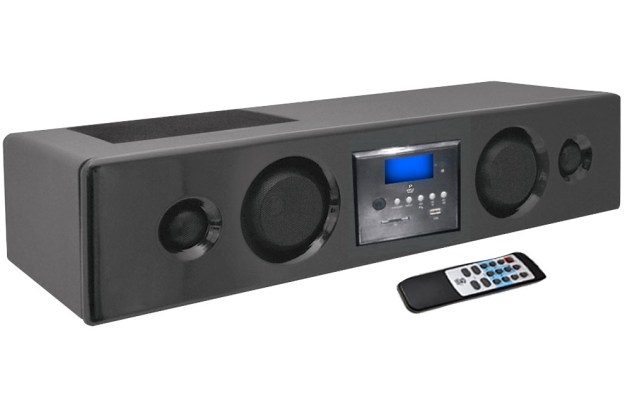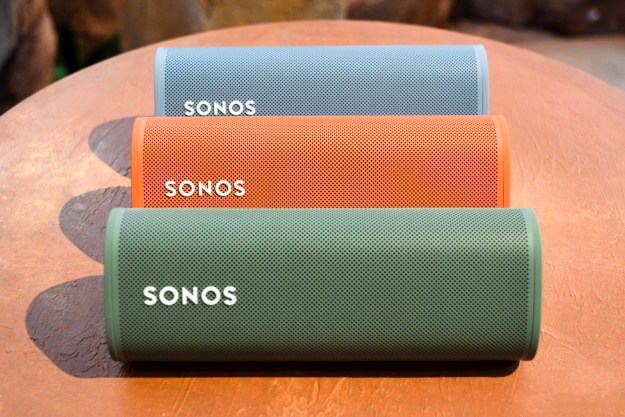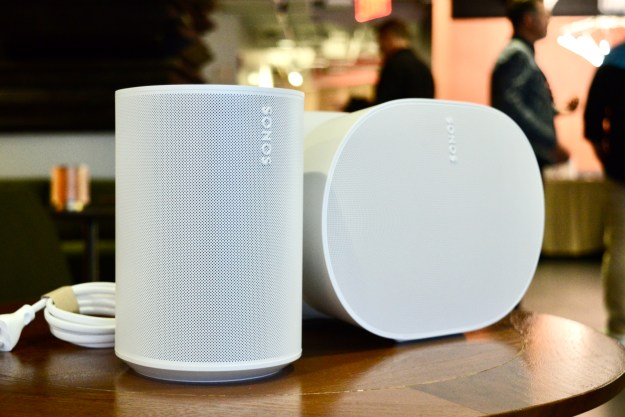
“If quantity trumps quality in your book, and you need something on the cheap, the V200 might suit you.”
- Robust bass
- Crisp treble
- Fairly impressive “3D” virtual surround processor
- Affordable
- Poor Bluetooth audio quality
- Weak midrange
- Lack of detail and depth
- Treble can be sharp at times
For most of its tenure, Pyle audio has been best known as one of those companies that helped fill high school parking lots everywhere with rattling car trunks. The company’s unusually colorful name originated from its Pyle Driver subwoofers, a series of speakers infamous for inspiring that raw sense of freedom that can only be felt by young people in the secure knowledge that their copy of Ready To Die is surely angering everyone in the neighborhood over the age of 25.
In recent years, the company has expanded its focus into the realm of home audio, marine audio, and even a pro audio line. And as anyone who’s been even remotely following the audio scene of late can surmise, that path inevitably leads to the same end: producing a Bluetooth speaker. Enter Pyle’s new “sound bar,” the PSBV200BT (V200).
The V200 involves a 2.1 sound system, multiple inputs, and a “3D” processing system which Pyle hopes will create a surround sound-like environment worthy of adorning your entertainment center. We recently sat down with the V200 to determine whether Pyle succeeded in breaking out of its car audio roots, and into the living room. Here’s what we found.
Out of the box
The V200’s packaging is a nostalgic throwback to the box store days of electronics: a plain cardboard box with large model numbers on the exterior opens to reveal the wide unit wedged between two pieces of good old, everlasting polystyrene foam. Pulling the rather cumbersome black device from the box, we found two plastic baggies of accessories including a quick start instruction manual, a 3.5mm cable, a power supply, and a small remote control with batteries.
Features and design
The V200’s sleek wooden frame is painted all-black, and complemented by gloss-black plastic front panel. In the center of the panel, between the system’s 4 main drivers, is a square command center which houses a blue backlit display, USB and SD card inputs, and a set of on-board controls.

Pressing the black power button on the front panel evokes a satisfying click, reminiscent of the tactile controls aboard a spaceship from a late ‘60’s sci-fi flick. Firing up the system, we found fairly succinct navigation through the V200’s row of silver keys, which include controls for input and standby, as well as three multifunction buttons which, when held, access their secondary function. The two search keys also control volume, while holding play/pause activates the unit’s speakerphone function.
The rest of the V200’s features are handled by remote control, including ample controls for FM radio navigation, bass and treble control, and activation of the “3D” sound processing feature.
The V200’s drivers consist of a pair of 1-inch tweeters at the far ends, with a pair of 2-inch midrange drivers flanking the center console, all encased by metal speaker screens. The unit’s 5.25 inch “subwoofer” is framed face-up to a square hole cut into the top left of the speaker box, and covered by a cloth screen. On the back panel is a small port for the sub, accompanied by the V200’s 2 RCA aux inputs, power cable input, and 3.5mm input which doubles as an FM antenna input. Unfortunately, there is no digital audio input, which limits connection options quite a bit. The system is powered by a hefty 300-watt amplifier, and runs through Pyle’s DSP.
To pair a Bluetooth device, one need only to press the Bluetooth input button. Piercing chimes confirm pairing mode, and the speaker shows up on your device with the generic title, “BT Speaker”. Once paired, you can navigate through your library of music from either the speaker’s remote control or from your device. We were disappointed to find the V200 employs Bluetooth version 2.0 +EDR, a protocol that is over 9 years old, and generally poor in sound quality.
Audio performance
As foreshadowed above, the near-ancient version of Bluetooth adopted by Pyle for the V200 recounts a tale of two input sources – wired vs. wireless – with very different results. Playing audio from your device via the V200’s most convenient feature (Bluetooth) is an exercise in pure annoyance. We don’t know how much money manufacturer’s save by using this old wireless protocol, but we do know that, whatever the sum, it is not worth the terrible sound quality.
Music or media played through the V200’s Bluetooth connection takes on a scratchy, dull presence, reminiscent of a mediocre FM radio connection. Sound is pushed into the background, with presence and timbre severely hampered, as if by a screen or barrier.
Music
Voices sounded a bit steely and thin, and the film’s gorgeous musical score lacked depth, with brass and strings falling flat.
Turning to lighter rock and acoustic music, we found midrange output to be pretty weak, robbing the system of potential excitement. While the small quartet of drivers provided a fairly clean upper register, there was a lack of fullness to instruments, resulting in a strained, tinny sound to brass, strings, and snare drum. Vocals, too, had a weak presence, with breathier voices sounding thin and fragile. There is almost a feeling of relief as the sub kicks in, adding much needed gravitas to the sound due to anemic midrange quality.
Multimedia
For us, the V200’s most impressive feature is its 3D digital processing, which propelled sound well beyond the boundaries of the speaker’s box. We had some enjoyable moments with the effect kicked in while listening to electronic music with wide sweeping effects swirling about the room. However, the processing did weird things to the music’s mix, pressing auxiliary instruments to the foreground, and expounding reverb to ridiculous levels on vocals, as if the singer we’re in a gigantic bathroom.
When we implemented the 3D feature for movies and gaming, we were much more pleased with the result. We queued up Peter Jackson’s epic The Fellowship of the Ring, and took in some satisfying moments. Galadriel’s whispering during the introductory scene seemed to come from far left of the speaker, and the exploding fireworks in the flick’s birthday party scene were rendered with a broad, circular ambience.

As for the overall sound, the powerful bass from the V200’s subwoofer delivered palpable excitement during scenes such as Sauron’s death at the beginning, or with sound effects like the thick thudding of horse hooves hitting the ground. The V200’s midrange weakness was apparent again, however. Voices sounded a bit steely and thin, and the film’s gorgeous musical score lacked depth, with brass and strings falling flat. There was also abrasiveness to the treble that was uncomfortable at times, compelling us to adjust the volume during treble-intensive scenes.
Conclusion
Priced at about $135, the PSBV200BT provides a highly affordable entry into home theater. We had some enjoyable moments while using the V200 for multimedia, thanks to some pounding bass and some impressive virtual surround effects. Music playback, however, is just not this speakers’ forte. Midrange output is weak, and treble can be harsh at times. All of that coupled with poor Bluetooth audio quality make for a bit of a disappointment on the whole. Still, $135.00 is mighty cheap for the sound that you do get from this speaker. If quantity trumps quality in your book, and you need something on the cheap, the V200 might suit you. Otherwise, we urge readers to look into any one of the many other sound bars available on the market today.
Highs
- Robust bass
- Crisp treble
- Fairly impressive “3D” virtual surround processor
- Affordable
Lows
- Poor Bluetooth audio quality
- Weak midrange
- Lack of detail and depth
- Treble can be sharp at times
Editors' Recommendations
- Best wireless speakers for 2024: Sonos, JBL, KEF, and more
- The best Bluetooth speakers for 2024: Marshall, Soundcore, JBL, and more
- The best speakers for 2024: great hi-fi options for music and more
- Anker Soundcore’s Motion X500 packs spatial audio into a more portable package
- Tivoli Audio reimagines its SongBook as two retro-style boomboxes







